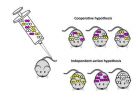(Press-News.org) WEST LAFAYETTE, Ind. — Researchers from the University of Texas at Austin's Cockrell School of Engineering are developing ground-improvement methods to help increase the resilience of homes and low-rise structures built on top of soils prone to liquefaction during strong earthquakes.
Findings will help improve the safety of structures in Christchurch and the Canterbury region in New Zealand, which were devastated in 2010 and 2011 by a series of powerful earthquakes. Parts of Christchurch were severely affected by liquefaction, in which water-saturated soil temporarily becomes liquid-like and often flows to the surface creating sand boils.
"The 2010-2011 Canterbury earthquakes in New Zealand have caused significant damage to many residential houses due to varying degrees of soil liquefaction over a wide extent of urban areas unseen in past destructive earthquakes," said Kenneth Stokoe, a professor in the Department of Civil, Architectural and Environmental Engineering. "One critical problem facing the rebuilding effort is that the land remains at risk of liquefaction in future earthquakes. Therefore, effective engineering solutions must be developed to increase the resilience of homes and low-rise structures."
Researchers have conducted a series of field trials to test shallow-ground-improvement methods.
"The purpose of the field trials was to determine if and which improvement methods achieve the objectives of inhibiting liquefaction triggering in the improved ground and are cost-effective measures," said Stokoe, working with Brady Cox, an assistant professor of civil engineering. "This knowledge is needed to develop foundation design solutions."
Findings were detailed in a research paper presented in December at the New Zealand – Japan Workshop on Soil Liquefaction during Recent large-Scale Earthquakes. The paper was authored by Stokoe, graduate students Julia Roberts and Sungmoon Hwang; Cox and operations manager Farn-Yuh Menq from the University of Texas at Austin; and Sjoerd Van Ballegooy from Tonkin & Taylor Ltd, an international environmental and engineering consulting firm in Auckland, New Zealand.
The researchers collected data from test sections of improved and unimproved soils that were subjected to earthquake stresses using a large mobile shaker, called T-Rex, and with explosive charges planted underground. The test sections were equipped with sensors to monitor key factors including ground motion and water pressure generated in soil pores during the induced shaking, providing preliminary data to determine the most effective ground-improvement method.
Four ground-improvement methods were initially selected for the testing: rapid impact compaction (RIC); rammed aggregate piers (RAP), which consist of gravel columns; low-mobility grouting (LMG); and construction of a single row of horizontal beams (SRB) or a double row of horizontal beams (DRB) beneath existing residential structures via soil-cement mixing.
"The results are being analyzed, but good and poor performance can already be differentiated," Stokoe said. "The ground-improvement methods that inhibited liquefaction triggering the most were RIC, RAP, and DRB. However, additional analyses are still underway."
The test site is located along the Avon River in the Christchurch suburb of Bexley. The work is part of a larger testing program that began in early 2013 with a preliminary evaluation by Brady Cox of seven potential test sites along the Avon River in the Christchurch area.
INFORMATION:
Funding for the research has been provided, in part, by the National Science Foundation and is affiliated with the NSF's George E. Brown Jr. Network for Earthquake Engineering Simulation (NEES). The remainder of the funding has been provided by the Earthquake Commission of the New Zealand Government.
The 64,000-pound T-Rex, operated by NEES@UTexas at UT Austin, is used to simulate a wide range of earthquake shaking levels.
NEES is a shared network of 14 experimental facilities, collaborative tools, a centralized data repository and earthquake simulation software, all linked by high-speed Internet connections.
Writer: Emil Venere, (765) 494-4709, venere@purdue.edu
Sources: Kenneth H. Stokoe, 512-232-3689, k.stokoe@mail.utexas.edu and
Sandra Zaragoza, UT Austin media contact, 512-471-2129, zaragoza@utexas.edu
Related Web sites: NEES
PHOTO CAPTION:
Researchers are using T-Rex, a 64,000-pound shaker truck, in research to increase the resilience of homes and low-rise structures built on top of soils prone to liquefaction during strong earthquakes. T-Rex is based at a University of Texas at Austin facility that is part of the George E. Brown Jr. Network for Earthquake Engineering Simulation (NEES), a distributed laboratory with 14 sites around the United States. (image credit/NEES photo)
A publication-quality graphic is available at http://www.purdue.edu/uns/images/2014/nees-trex.jpg
ABSTRACT
Effectiveness of inhibiting liquefaction triggering by shallow ground improvement methods: initial field shaking trials with TRex at one site in Christchurch, New Zealand
K. H. Stokoe, II, J. N. Roberts, S. Hwang, B. R. Cox & F. Y. Menq
The University of Texas at Austin
S. Van Ballegooy
Tonkin & Taylor Ltd, Auckland, New Zealand
Christchurch and the Canterbury region in New Zealand were devastated in 2010-2011 by a series of powerful earthquakes. The Christchurch area experienced widespread liquefaction that caused extensive damage. One critical problem facing the rebuilding effort is that the land remains at risk of liquefaction in future earthquakes. Therefore, effective engineering solutions must be developed to increase the resilience of homes and low-rise structures. To this end, a comprehensive series of full-scale field trials of multiple shallow ground improvement methods is underway. Initial field trials at one site involving five test panels of different ground improvements are presented. Each test panel and two unimproved natural soil test panels have been instrumented and characterized before shaking. A large mobile shaker, called T-Rex, has been used to perform an increasing sequence of dynamic horizontal loads to each test panel. The results are being analyzed but good and poor performance can already be differentiated.
Ground-improvement methods might protect against earthquakes
2014-03-21
ELSE PRESS RELEASES FROM THIS DATE:
Forests crucial to green growth
2014-03-21
NAIROBI, Kenya (21 March 2014) ----The value of forests and tree-based ecosystems extends far beyond carbon sequestration; they are the foundation of sustainable societies.
A new report, launched in Jakarta, Indonesia on 21 March - the International Day of Forests – promotes REDD+ and the Green Economy as together providing a new pathway to sustainable development that can benefit all nations. It claims this approach can conserve and even boost the economic and social benefits forests provide to human society.
Building Natural Capital – How REDD+ Can Support a Green ...
Pathogens in cheese
2014-03-21
Listeria is a rod-shaped bacterium highly prevalent in the environment and generally not a threat to human health. One species however, Listeria monocytogenes, can cause listeriosis, a very dangerous disease. This pathogen can be present in raw milk and soft cheeses, smoked fish, raw meat and ready-to-eat products. In Austria, health care providers are required to report all cases of listeriosis, which can be fatal particularly for patients with weakened immune systems. In 2009 and 2010, a dairy in Hartberg (Styria, Austria) produced Quargel cheese contaminated with Listeria ...
In rats, diffuse brain damage can occur with no signs of 'concussion,' reports study in Neurosurgery
2014-03-21
Philadelphia, Pa. (March 21, 2014) – A standard experimental model of concussion in rats causes substantial brain damage—but no behavioral changes comparable to those seen in patients with concussion, reports a study in the April issue of Neurosurgery, official journal of the Congress of Neurological Surgeons. The journal is published by Lippincott Williams & Wilkins, a part of Wolters Kluwer Health.
The results highlight the "disconnect" between preclinical and clinical studies of concussion, according to the report by Dr. Charles L. Rosen of West Virginia University, ...
Genetic evidence for single bacteria cause of sepsis identified for the first time
2014-03-21
An international team of academics, including Professor Marco Oggioni from the University of Leicester's Department of Genetics, has studied how localised infections can turn into the dangerous systematic disease sepsis – and has identified for the first time through genetic evidence that a single bacteria could be the cause.
The study, which has been published in the academic journal PLOS Pathogens, examined the events that lead to sepsis by Streptococcus pneumoniae (pneumococcus), a major human pathogen, in mice. They found that in most cases the bacteria causing sepsis ...
Lightweight construction materials of highest stability thanks to their microarchitecture
2014-03-21
This news release is available in German. KIT researchers have developed microstructured lightweight construction materials of highest stability. Although their density is below that of water, their stability relative to their weight exceeds that of massive materials, such as high-performance steel or aluminum. The lightweight construction materials are inspired by the framework structure of bones and the shell structure of the bees' honeycombs. The results are now presented in the journal PNAS, DOI: 10.1073/pnas.1315147111.
"The novel lightweight construction materials ...
New method can diagnose a feared form of cancer
2014-03-21
The poor prognosis for pancreatic cancer, where only 5 percent of the patients survive five years after the diagnosis, is due to the fact that the tumors often develop unnoticed, and rarely cause symptoms until they have spread to other organs. Recent studies, however, have shown that fluid-filled compartments in the pancreas, called cysts, may be precursors of the cancer.
Cysts in the pancreas, which are found in every 10th person above the age of 70, and are also common in younger people, can be discovered with computed tomography (CT) or magnetic resonance imaging ...
Genetic factor contributes to forgetfulness
2014-03-21
Misplaced your keys? Can't remember someone's name? Didn't notice the stop sign? Those who frequently experience such cognitive lapses now have an explanation. Psychologists from the University of Bonn have found a connection between such everyday lapses and the DRD2 gene. Those who have a certain variant of this gene are more easily distracted and experience a significantly higher incidence of lapses due to a lack of attention. The scientific team will probably report their results in the May issue of "Neuroscience Letters," which is already available online in advance.
Most ...
Salivary biomarkers of gingivitis: Information important for personalized decision-making
2014-03-21
Alexandria, Va., USA – Today during the 43rd Annual Meeting & Exhibition of the American Association for Dental Research, held in conjunction with the 38th Annual Meeting of the Canadian Association for Dental Research, Craig Miller, University of Kentucky, Lexington, will present research titled "Salivary Biomarkers of Gingivitis: Information Important for Personalized Decision-Making."
Salivary biomarkers have been studied to help determine the presence, risk, and progression of periodontal disease. However, clinical translation of salivary biomarkers from bench to ...
Novel pro-resolving-medicines in periodontal regeneration
2014-03-21
Alexandria, Va., USA – Today during the 43rd Annual Meeting & Exhibition of the American Association for Dental Research, held in conjunction with the 38th Annual Meeting of the Canadian Association for Dental Research, Daniel Huy Nguyen, The Forsyth Institute, Cambridge, Mass., will present research titled "Novel Pro-Resolving-Medicines in Periodontal Regeneration."
Uncontrolled host defense mechanisms can significantly impede tissue engineering, regeneration and reconstruction of oral and craniofacial tissues. The anti-inflammatory and pro-resolving actions of lipoxins ...
Water fluoridation: Safety efficacy and value in oral health care
2014-03-21
Alexandria, Va., USA – Today during the 43rd Annual Meeting & Exhibition of the American Association for Dental Research, held in conjunction with the 38th Annual Meeting of the Canadian Association for Dental Research, a symposium titled "Water Fluoridation: Safety Efficacy and Value in Oral Health Care" will take place. This symposium will be chaired by Stephen H. Abrams, Cliffcrest Dental Office, Toronto, Ontario, Canada.
Community water fluoridation (CWF) and other fluoride modalities historically have been and remains the cornerstone for the prevention and control ...



